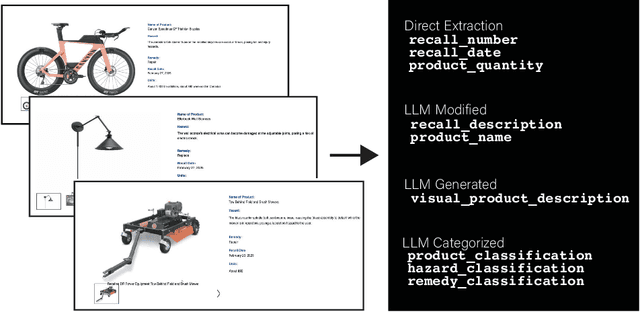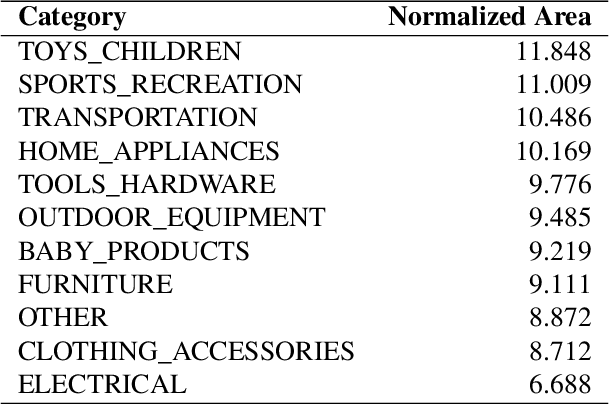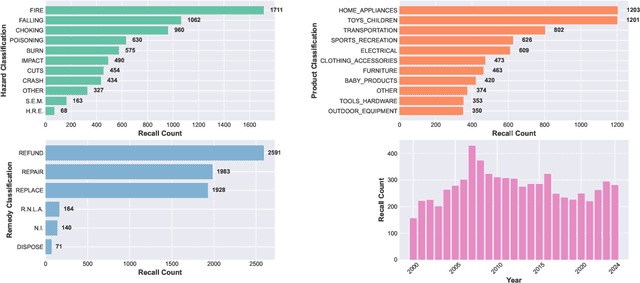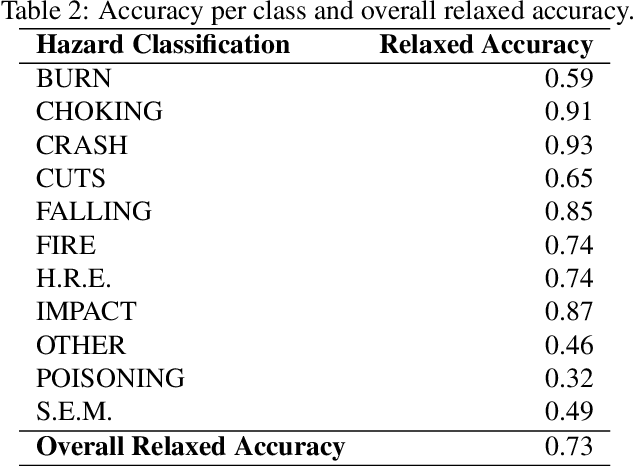Kosa Goucher-Lambert
RECALL-MM: A Multimodal Dataset of Consumer Product Recalls for Risk Analysis using Computational Methods and Large Language Models
Mar 29, 2025



Abstract:Product recalls provide valuable insights into potential risks and hazards within the engineering design process, yet their full potential remains underutilized. In this study, we curate data from the United States Consumer Product Safety Commission (CPSC) recalls database to develop a multimodal dataset, RECALL-MM, that informs data-driven risk assessment using historical information, and augment it using generative methods. Patterns in the dataset highlight specific areas where improved safety measures could have significant impact. We extend our analysis by demonstrating interactive clustering maps that embed all recalls into a shared latent space based on recall descriptions and product names. Leveraging these data-driven tools, we explore three case studies to demonstrate the dataset's utility in identifying product risks and guiding safer design decisions. The first two case studies illustrate how designers can visualize patterns across recalled products and situate new product ideas within the broader recall landscape to proactively anticipate hazards. In the third case study, we extend our approach by employing a large language model (LLM) to predict potential hazards based solely on product images. This demonstrates the model's ability to leverage visual context to identify risk factors, revealing strong alignment with historical recall data across many hazard categories. However, the analysis also highlights areas where hazard prediction remains challenging, underscoring the importance of risk awareness throughout the design process. Collectively, this work aims to bridge the gap between historical recall data and future product safety, presenting a scalable, data-driven approach to safer engineering design.
Exploring the Capabilities of Large Language Models for Generating Diverse Design Solutions
May 02, 2024Abstract:Access to large amounts of diverse design solutions can support designers during the early stage of the design process. In this paper, we explore the efficacy of large language models (LLM) in producing diverse design solutions, investigating the level of impact that parameter tuning and various prompt engineering techniques can have on the diversity of LLM-generated design solutions. Specifically, LLMs are used to generate a total of 4,000 design solutions across five distinct design topics, eight combinations of parameters, and eight different types of prompt engineering techniques, comparing each combination of parameter and prompt engineering method across four different diversity metrics. LLM-generated solutions are compared against 100 human-crowdsourced solutions in each design topic using the same set of diversity metrics. Results indicate that human-generated solutions consistently have greater diversity scores across all design topics. Using a post hoc logistic regression analysis we investigate whether these differences primarily exist at the semantic level. Results show that there is a divide in some design topics between humans and LLM-generated solutions, while others have no clear divide. Taken together, these results contribute to the understanding of LLMs' capabilities in generating a large volume of diverse design solutions and offer insights for future research that leverages LLMs to generate diverse design solutions for a broad range of design tasks (e.g., inspirational stimuli).
Conceptual Design Generation Using Large Language Models
May 30, 2023Abstract:Concept generation is a creative step in the conceptual design phase, where designers often turn to brainstorming, mindmapping, or crowdsourcing design ideas to complement their own knowledge of the domain. Recent advances in natural language processing (NLP) and machine learning (ML) have led to the rise of Large Language Models (LLMs) capable of generating seemingly creative outputs from textual prompts. The success of these models has led to their integration and application across a variety of domains, including art, entertainment, and other creative work. In this paper, we leverage LLMs to generate solutions for a set of 12 design problems and compare them to a baseline of crowdsourced solutions. We evaluate the differences between generated and crowdsourced design solutions through multiple perspectives, including human expert evaluations and computational metrics. Expert evaluations indicate that the LLM-generated solutions have higher average feasibility and usefulness while the crowdsourced solutions have more novelty. We experiment with prompt engineering and find that leveraging few-shot learning can lead to the generation of solutions that are more similar to the crowdsourced solutions. These findings provide insight into the quality of design solutions generated with LLMs and begins to evaluate prompt engineering techniques that could be leveraged by practitioners to generate higher-quality design solutions synergistically with LLMs.
How does agency impact human-AI collaborative design space exploration? A case study on ship design with deep generative models
May 16, 2023Abstract:Typical parametric approaches restrict the exploration of diverse designs by generating variations based on a baseline design. In contrast, generative models provide a solution by leveraging existing designs to create compact yet diverse generative design spaces (GDSs). However, the effectiveness of current exploration methods in complex GDSs, especially in ship hull design, remains unclear. To that end, we first construct a GDS using a generative adversarial network, trained on 52,591 designs of various ship types. Next, we constructed three modes of exploration, random (REM), semi-automated (SAEM) and automated (AEM), with varying levels of user involvement to explore GDS for novel and optimised designs. In REM, users manually explore the GDS based on intuition. In SAEM, both the users and optimiser drive the exploration. The optimiser focuses on exploring a diverse set of optimised designs, while the user directs the exploration towards their design preference. AEM uses an optimiser to search for the global optimum based on design performance. Our results revealed that REM generates the most diverse designs, followed by SAEM and AEM. However, the SAEM and AEM produce better-performing designs. Specifically, SAEM is the most effective in exploring designs with a high trade-off between novelty and performance. In conclusion, our study highlights the need for innovative exploration approaches to fully harness the potential of GDS in design optimisation.
ShipHullGAN: A generic parametric modeller for ship hull design using deep convolutional generative model
Apr 29, 2023Abstract:In this work, we introduce ShipHullGAN, a generic parametric modeller built using deep convolutional generative adversarial networks (GANs) for the versatile representation and generation of ship hulls. At a high level, the new model intends to address the current conservatism in the parametric ship design paradigm, where parametric modellers can only handle a particular ship type. We trained ShipHullGAN on a large dataset of 52,591 \textit{physically validated} designs from a wide range of existing ship types, including container ships, tankers, bulk carriers, tugboats, and crew supply vessels. We developed a new shape extraction and representation strategy to convert all training designs into a common geometric representation of the same resolution, as typically GANs can only accept vectors of fixed dimension as input. A space-filling layer is placed right after the generator component to ensure that the trained generator can cover all design classes. During training, designs are provided in the form of a shape-signature tensor (SST) which harnesses the compact geometric representation using geometric moments that further enable the inexpensive incorporation of physics-informed elements in ship design. We have shown through extensive comparative studies and optimisation cases that ShipHullGAN can generate designs with augmented features resulting in versatile design spaces that produce traditional and novel designs with geometrically valid and practically feasible shapes.
 Add to Chrome
Add to Chrome Add to Firefox
Add to Firefox Add to Edge
Add to Edge